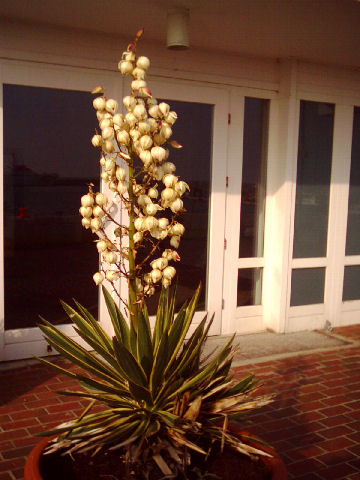
Inspection Round October 2006
The transport of many “exotics” represented no problem this time. I sent most of them by ePaket (orders ordered in the internet and the packages fetched by the DHL from at home).
Ulf had planted the most of the "exotics" out. Also we got larger quantities of trachy seed, which were sent to Ulf and they were sown by him out.
On October 19th we could then to the island finally, for that I took vacation. Chris came at seven o'clock, because we had to transport one approx. 8 feet tall Diospyros lotus, because a DHL shipment with this size was not possible because of the mass. It worked to transport the Diospyros lotus by the underground. Also the transport by the Halunderjet worked without problems, so that Ulf could receive it directly at the jetty.
At the ferry house “Marina” I discovered a flowering Yucca gloriosa 'Variegata', the blooms look strongly like the of one yucca. I regarded it as a Furcraea longaeva 'Variegata' at that time. Beautiful Chamaerops in pots were to be also found there.

Yucca gloriosa 'Variegata' at the ferry house "Marina"
in flower.
Then we passed the “Insulaner” Jubaea from Tobias Spanner. The Jubaea has got five new feathers in this year. Actually the four feathers from the past year could still be to, but they were unfortunately removed. The feathers became somewhat smaller than before, probably by the establishment procedure. The feathers from 2003 were probably grown in the greenhouse, so that they appeared longer and larger. We want to hope that the Jubaea also will get slowly larger feathers with every year now. Ulf wants to tie them together slightly if necessary in the winter.
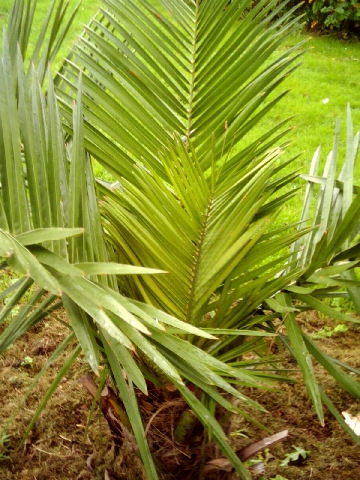
The "Insulaner" Jubaea has got 5 new healthy
feathers this year!
We went with Ulf to the James Kruess School and I discovered on the planting island on the schoolyard the Pittosporum tobira, which grew very well. This did not have problems with the past two for Heligoland quite cold winters (lowest temperature in each case 24°F, measured over the water of the North Sea by the weather service). One species which can be recommended for Heligoland very much.
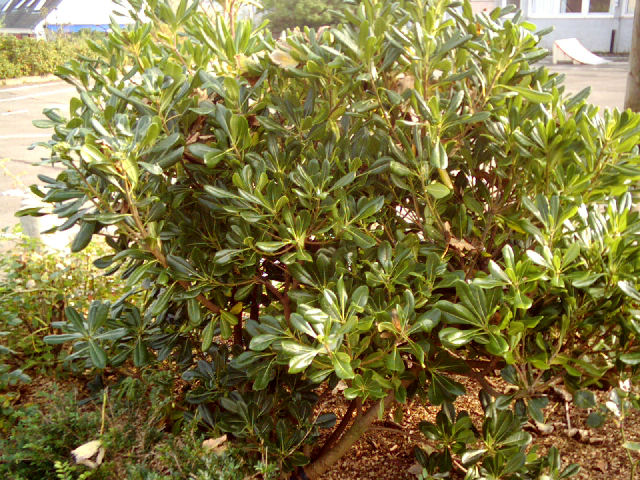
Pittosporum tobira on the planting yard on the schoolyard of the James
Kruess School thrives excellent and is perfect for Heligoland!
Also the Chamaerops humilis in the two of the four atria of the school had no problems with the past winters, completely hardy for Heligoland.
One approx. 7 feet tall Araucaria angustifolia from Dr. Bernhard Demes has Ulf planted out, it is the Paraná Pine from South Brazil. Whether it does survive the next winters well and feels as well as Araucaria araucana here? We have no doubts.
Pinus radiata, Cupressus macrocarpa 'Goldcrest', Trachycarpus fortunei, T. wagnerianus, T. takil 'Kumaon', Phygelius capensis pink (cape fuchsia from South Africa), Phormium tenax, Aloe striatula, Delosperma cooperi, some Opuntia species and Diospyros kaki have kept very well and might be suitable for Heligoland. Also Arbutus unedo has proved as perfect. One outplanted olive also carried fruits. One small Butia capitata came through the both past winters.
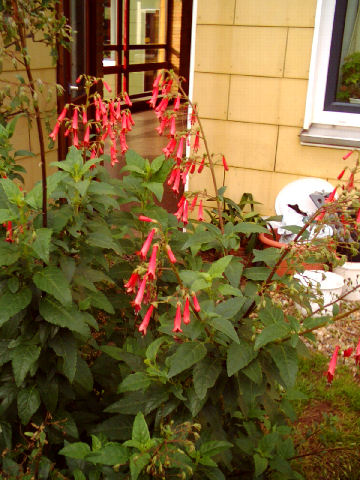
Phygelius capensis rose is grown to one flowering
splendour specimen, also perfect for the island!
This beautiful plant should be planted on the
island more frequently.
The Phormium tenax is even grown enormously, well suitable like also Pittosporum tobira and Aloe striatula. Pittosporum ralphii self came through very well and shown a very good growth, is also like P. tobira ideal for the island.
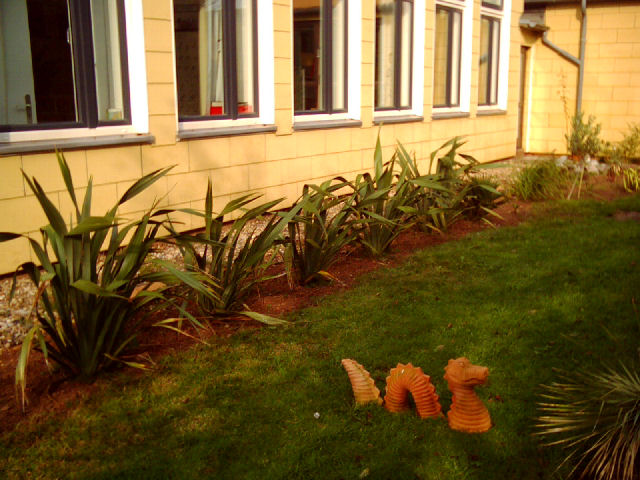
Phormium tenax is grown on Heligoland really enormously, should be planted
on the island more frequently!
Aloe striatula should be planted on Heligoland much more frequently, there this is dryness-resistant, sea-salt wind resistant and frost hardy. On the mainland it is but not hardy and/or needs winter protection such as rain protection closely at a sheltered and warm wall.
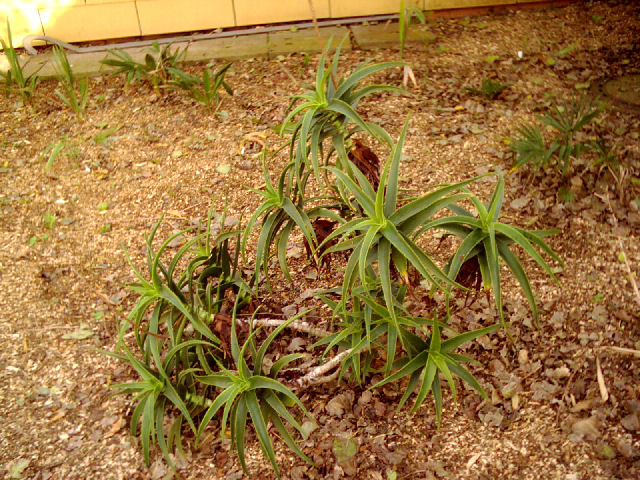
Aloe striatula came through the both past winters well!
We preserve now the suspicion that above all New Zealanders of the south island and from the New Zealander alps and South Africans are suitable well for the cultivation on Heligoland. Smaller Rhopalostylis sapida Ulf has planted out. Whether they do survive the coming winters? Likewise Delosperma cooperi could be planted on Heligoland much more. Other species of midday flower and some other species of aloe could be tried.
The large trachies, above all Trachycarpus wagnerianus, grew this year very well and look even much better than in the past years. The petioles are even much shorter and the fans some smaller, probably one adjustment to the sea-climate conditions of Heligoland.
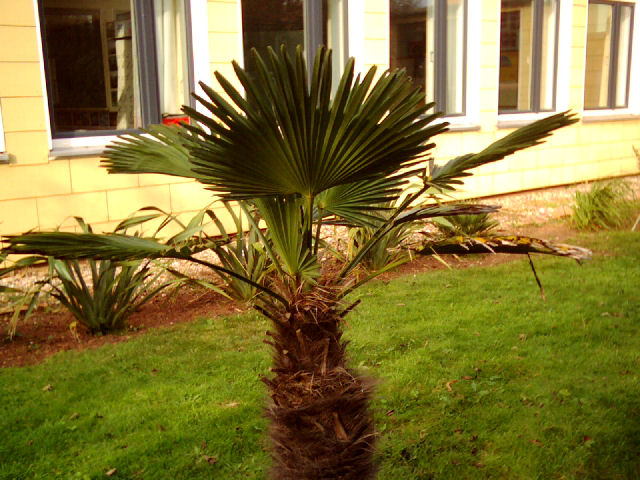
Trachycarpus wagnerianus from Tobias Spanner has shorter petioles and has
etablished well!
In the atrium with the pond (atrium #1) we expericend a surprise. The Acca sellowiana has taken nevertheless. The shoots are shorter and more compact, the leaves are adapted to the sea-climate conditions. Might grow on Heligoland more compact and more slowly, but completely hardy, during on the mainland hardly hardy and/or only with thermostat-steered heated winter protection.
The large Phoenix canariensis from OBI from the Outplantations Spring 2005 has survived the past winter, but has grown smaller feathers, which are much denser, harder and shorter.von This occupies impressively the having the habitus change at one and the same plant due to changed environmental condition!
Also one Musa basjoo has survived the second winter outdoors without any protection, but less than 2 feet tall, not larger than in the past year. However not the largest Musa basjoo of Heligoland. The atrium #1 will be transformed and also to be converted into one right exotic garden.
Pseudoarundinaria japonica, Phyllostachys bissettii, some other Phyllostachys species and Arundo donax have kept. With bamboo all proved suitable for the coast, but there are surely more sea-salt compatible species. Arundo donax. proved but as well suitable for Heligoland, needs however a deep soil.
Likewise Yucca rostrata emerged as very good for Heligoland, one of the two has survived the long past winter well, without rain protection. The other one of the two was outplanted only this year. On the mainland it is rather difficulty to keep and needs rain protection. Many tree yucca species, which are rather difficulty on the mainland, could have much better chances on Heligoland.
We reached the power station on the Northeastern Area to look after my Musa basjoo 'Sapporo'. It actually lives and is probably the largest Heligolandian Helgoländer Musa basjoo, approx. 3 feet tall, much larger than the basjoo in the school and the in the garden of the hotel "Insulaner". That proves that bananas can thrive on Heligoland, but need a warm and good wind-sheltered place as well as a loose and deep soil, which must be fertilized regulary. The power station at a wind-sheltered place fulfills these conditions, fortunately the basjoo is well maintained. Even three Citrus lemon (lemon) we discovered in a good condition there. Actually Citrus lemon is not hardy on the mainland, takes only some degrees of frost for short time. Possibly they should receive a winter protection at the power station. Also one Cordyline australis in one large ceramic box we discovered, as well as a Rosmarinus officinale.
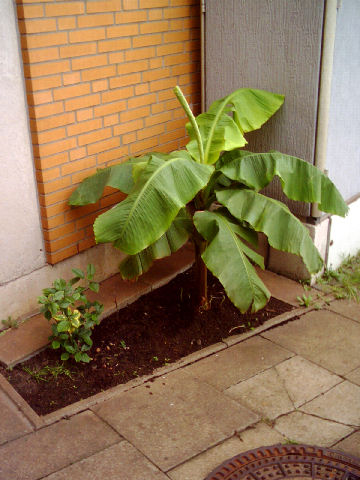
Probably the largest Musa basjoo of Heligoland
at the power station!
The free lawn place at the power station would be an ideal place for one larger Jubaea chilensis or Butia capitata, much better than the site of the "Insulaner" Jubaea. The Washingtonia filifera beside the current switchbox looked good, but some smaller than in the past year. But whether is the same like the in the past year? The trunk shows no petioles from the past year.
Arrived at the swimming pool, we looked after the large Trachycarpus wagnerianus from Tobias Spanner. It is grown well, but also with more compacter and shorter petioles. At the mini gulf place we photographed an older Yucca gloriosa with several trunks. Further one large Laurus nobilis and Euonymus japonica are on the area. The Laurus was distinguished as such by a label.
To the Mielck House we also went, but we couldn't enter the atrium, because Prof. Dr. Wiltshire was in the vacaction. Despite of that we could look after the trachies, holm oaks and laurel on the yard in the front of the house, they were in the good condition and have recovered again well from the bad sea-salt storm winter 2004/05. Even the transplanted trachy is regrown well, it has much shorter petioles because it stands now more in the sun. One proof for one change of the phenotype due to the changed site conditions again.
On the next day we went to the James Kruess School again and wanted to know what was happen with the sown trachy seed. Really also some were germinated in situ, partly Ulf has taken some out and potted them in, thus school children cannot pull them out. But at some covered places they were stayed and are even in a good condition, must be however further watched. Ulf let also sow trachy seed on the Dune, the small neighbour island. Thus the sea-salt resistance should be tested.
We went down to the Lower Town again to look after the "exotics" on the yard in the front of the house "Witte Kliff" and experienced there one surprise. Nerium oleander still thrives after its second winter very well there. Cyperus alternifolius thrives without problems at the same. One Callistemon laevis also has experienced its second outdoor winter, is now going into the third outdoor winter. But best suitable for Heligoland seems be Callistemon rigidus, has survived in one atrium of the James Kruess School the past winter completely undamaged. Also Phyllostachys aureum and Trachycarpus fortunei closed at the wall of the house "Witte Kliff" are in the very good condition, the past August has probably caused that, the August was cool and rainy, but the September was warm.
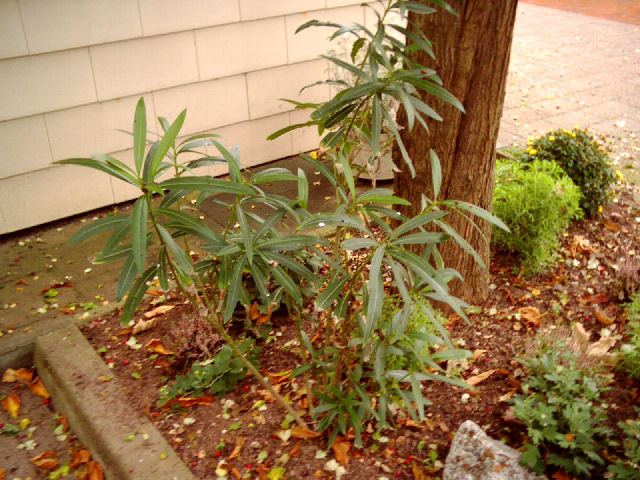
Nerium oleander at the house "Witte Kliff" has survived the both past winters
windprotected well!
Pleioblastus simonii near the hotel "Atoll" has kept. In the garden of the hotel "Insulaner" we checked the status of the outplanted "exotics". One smaller Butia capitata on the lawn has survived its second winter better than its first winter. Has grown two feathers in this year, in the past year only one and half feathers, the feathers of the past year also were in the better condition. Also the Arbutus unedo was in the full bloom again and looked even much better than in the past year, seems to be etablished very good, could be planted much more on Heligoland in the same like Phormium tenax, Aloe striatula, Pittosporum tobira and P. ralphii and Chamaerops humilis.Also the Aloe striatula in the garden of the hotel "Insulaner" was in the best health like also Agaphanthus praecox, Yucca recurvifolia x gloriosa (?), Chamaerops humilis and Phyllostachys aureum.
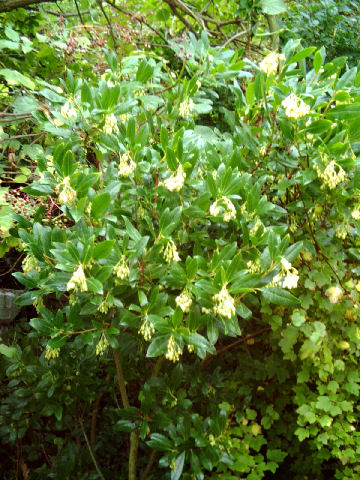
Arbutus unedo in the bloom in the garden of the
hotel "Insulaner", earns one further spreading
on the island!
The Musa basjoo 'Sapporo' has survived, is but smaller than its colleague at the power station, because the site is not so favorable and the soil is rocky and not so deeply and the place is windy.
Also after further trachies Trachys and Chamaerops we saw in the Lower Town, they all made sahen wir in der Unterstadt, they all made a good impression on us. Trachies are now relative common on Heligoland, are completely hardy there, ever more Heligolandians are planting trachies. From time to time we found different Hebe species, wich are not sufficiently hardy on the mainland, also rosmarin, fuchsias with ripening fruits, curry herb (Helichrysum italicum) and lavendel in the gardens. At the bistro "Sanisbar" the both Cordyline australis have survived outplanted its third outdoor winter without problems and are larger now.
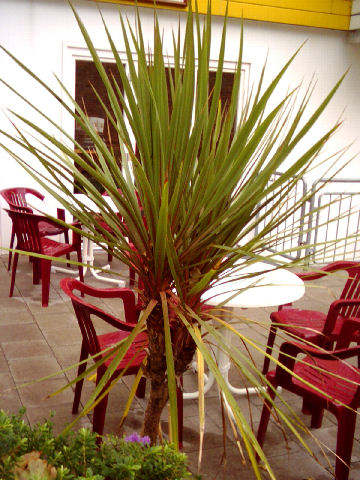
Of the both Cordyline australis at the bistro
"Sansibar" after its third outdoor winter.
Later we found in the Upper Town the probably largest trachy of Heligoland. It stands very closed at one house, the trunk foot is some creeping, but the trunk is grown very fine, the trachy is totally approx. 13 feet tall and a well developed leaf crown, which was scattered by direct wind effect. With continuing we discovered further trachies which are smaller, at the same several beautiful araucarias and several flowering pampas grasses (Cortaderia selloana) and also one flowering Fatsia japonica.
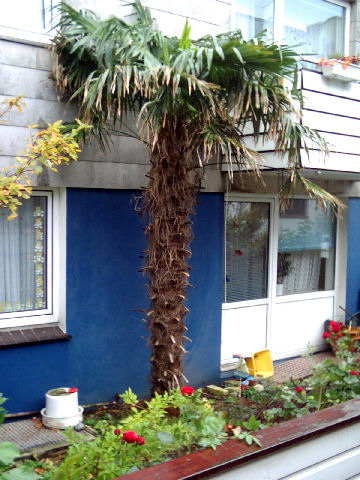
Probably the largest trachy of Heligoland in
the Upper Town!
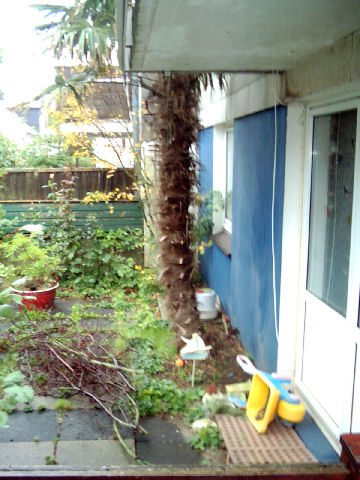
The some creeping trunk foot of the probably
largest trachy of Heligoland.
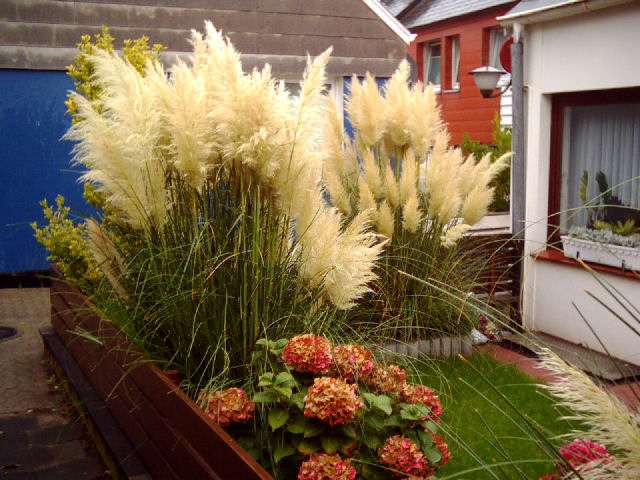
Magnificently flowering pampas grasses (Cortaderia selloana) in the Upper
Town!
In the garden of Ulf we experienced that Trachycarpus martianus 'Nepal' and T. wagnerianus have survived the past winter well totally undamaged. Trachycarpus martianus 'Nepal' has proved as very good suitable for Heligoland, much more further specimens of this species should be planted on Heligoland. Ulf has got one further larger Trachycarpus fortunei in the pot, also one larger Yucca recurvifolia x gloriosa (?) he has in the pot. Also the larger Cordyline australis var. atropurpurea in the pot in his garden could be planted out, there one smaller outplanted specimen has already survived its second outdoor winter well. At the same the Chamaerops humilis and Rhododendron macabeanum have kept there well.
It would be fine, if one further second larger Jubaea chilensis could stand at the power station, or also one smaller in the garden of the hotel of the mom of Ulf. Good conversion possiblities exist. Also further tree yuccas would be suitable, at the same further South Africans and South Zealanders.
Photo Gallery About The Inspection Round October 2006 (unfortunately only in German, please click the link on!)
Author: Joachim Jaeck
Translated November, 24th, 2005